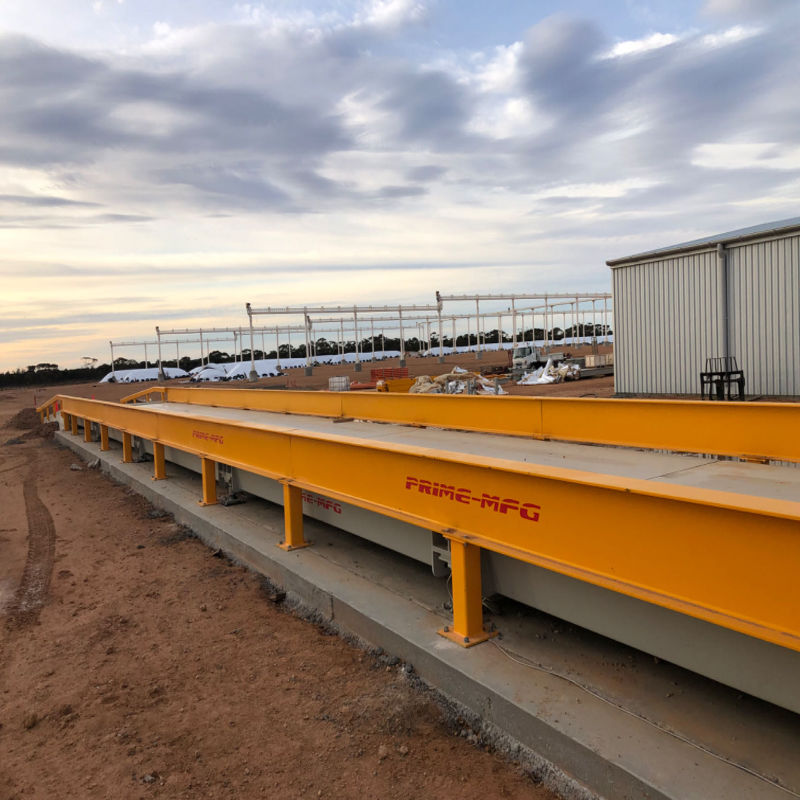Weighbridges

all-steel construction, making it robust and durable, capable of withstanding heavy-duty operations
- Utilizes advanced sensors and electronic measurement technology to ensure accurate weighing results with minimal error.
Our Weighbridges
A weighbridge is a high-precision device used to measure the weight of vehicles and cargo. It is widely used in logistics, transportation, warehousing, and industrial and mining sectors. The equipment features an all-steel construction, making it robust and durable, capable of withstanding heavy-duty operations in various harsh environments, ensuring the accuracy and reliability of the weighing results.


Weighbridge Features
High-Precision Weighing
Utilizes advanced sensors and electronic measurement technology to ensure accurate weighing results with minimal error.
Robust and Durable
Made with high-strength all-steel construction, offering excellent durability and impact resistance, suitable for various harsh working environments.
Easy Installation and Maintenance
Modular design ensures easy installation and low maintenance costs, guaranteeing long-term stable operation.
User-Friendly
Equipped with an ergonomic interface that is simple and intuitive, allowing users to easily set and adjust parameters.
High Safety
Features overload protection and lightning protection design, ensuring the safety of both the equipment and the operators.
Unattended System
Automatically records weighing vehicle details, time, weight, tare weight, gross weight, and net weight. By using a weighbridge, companies can significantly improve weighing efficiency and accuracy, ensure data reliability, optimize logistics management and production processes, and enhance overall operational efficiency and safety.
Applications
Logistics Industry
Used for weight verification of goods entering and leaving warehouses, ensuring the accuracy of logistics and transportation.
Transportation Industry
Used for vehicle load detection to prevent overloading and ensure driving safety.
Warehousing Industry
Used for weight management of inventory goods, improving warehouse management efficiency. Industrial and Mining Sectors: Used for weight measurement of bulk materials such as ore and coal, ensuring the accuracy of production data.
Gallery
Weighbridge Working Principle
Prime’s weighbridge consists of a sturdy platform, known as the weighbridge platform, constructed using reinforced concrete or steel. Load cells, which are sensors placed strategically beneath the platform, measure the force or weight applied by the vehicle. These load cells, typically made of materials like steel or aluminum, use strain gauges to convert the applied force into an electrical signal. The electrical signals from the load cells are collected and processed in an electronic junction box, which serves as a central point for signal aggregation and calibration. The junction box is connected to each load cell, and it ensures accurate measurement of the vehicle’s weight. The load cell signals are then summed up and processed to calculate the total weight.
To provide an interface for users, Prime’s weighbridge includes an indicator. The indicator displays the weight readings and allows the operator to interact with the system. It typically features a digital display, control buttons, and various settings for configuring the weighbridge operation. Before weighing, the vehicle is driven onto the weighbridge platform, ensuring that all the vehicle’s axles are fully supported. Once the vehicle is correctly positioned, the load cells measure the force or weight applied by the vehicle. The load cell signals are transmitted to the electronic junction box, where they are processed and summed up to calculate the total weight accurately.
To maintain accuracy, weighbridges need periodic calibration using known weights. This calibration process adjusts the load cell readings to match the actual weight standards. By periodically calibrating the system, accurate and reliable weight measurements can be ensured.
Prime’s weighbridge systems include software for data management. This software records and stores the weight measurements along with other relevant information, such as vehicle identification, date, and time. It can generate reports, perform data analysis, and integrate with other business systems to facilitate efficient management of weighing operations.
